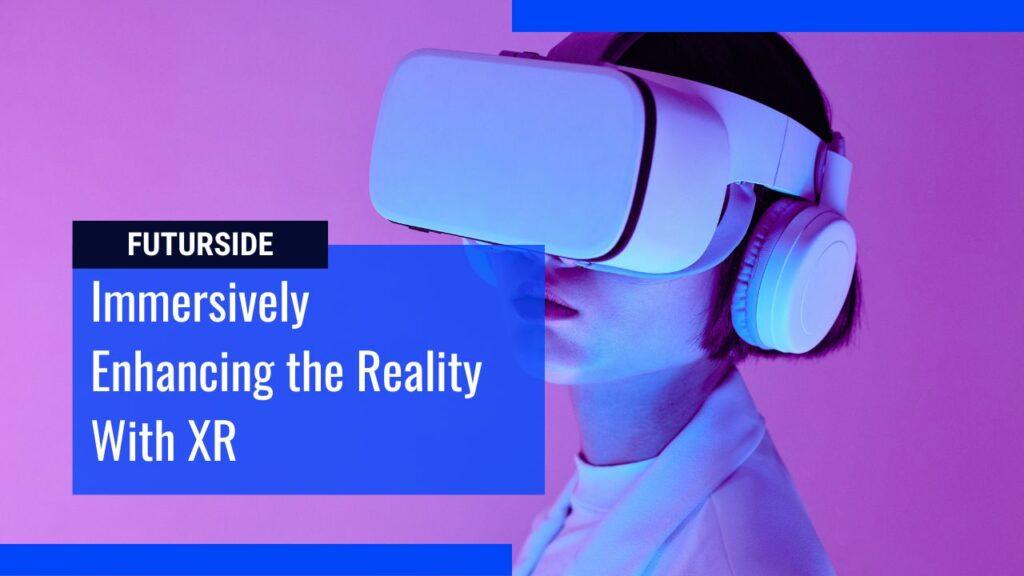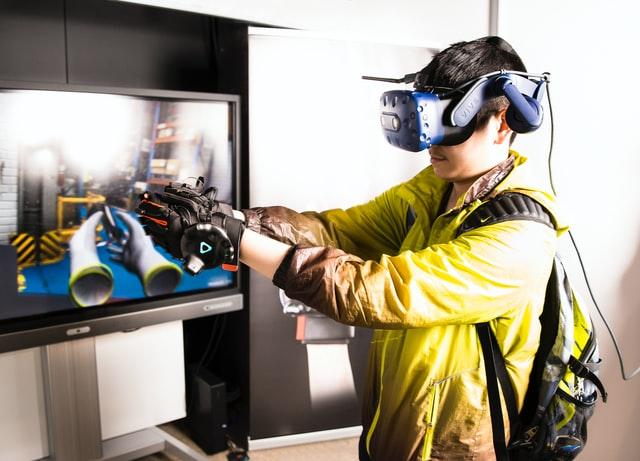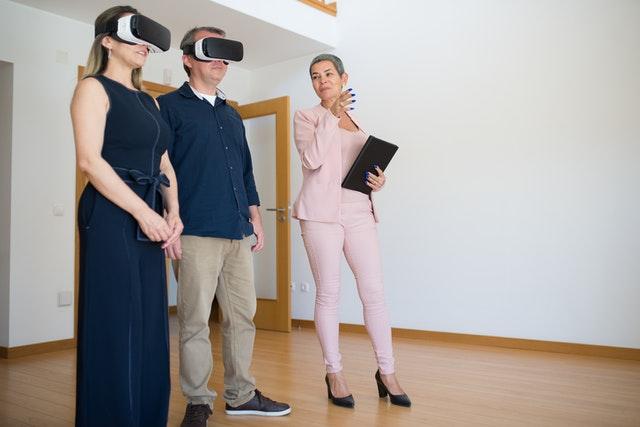Human beings are curious by nature, this is why we always wonder about the future. Even when thinkings about the past, we are hardwired to find patterns to better predict future outcomes. Now it is undeniable that the future of our civilization is technology. Most sci-fi movies have always portrayed a future where humans use fancy gadgets to fulfill all their needs by command.
Technologies that give us sci-fi-like experiences nowadays are Virtual Reality and Augmented Reality. These technologies have become increasingly popular and widespread in recent years, and both are useful in a range of applications. For example, VR video games can take people to specific locations in history.
And augmented reality can scan course literature to provide additional information to a mobile user. While AR is still in its early stages, it’s already starting to make its way into the mainstream. But perhaps the immersive technology that will make us feel we are living in the future is going to be XR or extended reality. So what is the hype around extended reality?

Contents
What is extended reality?
Extended reality encompasses different immersive technology such as virtual, augmented, and mixed reality. The “X” in XR can be used as a variable which means that it can be interchanged. This allows the X in XR to stand for virtual (V), augmented (A), and mixed (M).
The most common immersive technology is Virtual Reality (VR) which creates a simulated experience that is completely different from the real world. Augmented Reality (AR) on the other hand is not a completely immersive virtual experience, instead, it is the merging of the real and virtual worlds with overlaid imagery.
AR’s purpose is to enhance the real world with computer-generated information across sensory modulates. Mixed Reality (MR) is the merging of real and virtual worlds where physical and digital objects coexist and interact in real-time. MR does not exclusively take place in either the physical or the virtual world but it is rather a hybrid of the two.
We have three main realities that compose XR. Instead of having different devices for each realm like VR goggles, AR headsets, and MR gears, XR eventually produces all realities in a single station. We’ve already seen the possibility of AR, VR, and MR, but there’s more to this new technology. Extended reality combines the best elements of all realities to create an intuitive interface.
Extending reality will redefine the way we live and work by blending the real and virtual worlds together. It is a rapidly-evolving technology that combines physical and virtual environments. The use of this technology is not just limited to video games and movies, it’s becoming increasingly important in all fields of human endeavor.
For example, holographic representations can be used in meetings and classrooms, and spatial sound can be utilized in a class setting. XR has the potential to use object detection, mapping, and spatial understanding to give users an interactive and immersive experience. Today, smartphones can run AR applications. However, more advanced gear will improve the experience.
With new immersive technology, even a first grader can experience the moon, climb mountains, and train on a lightsaber. You can experience a virtual world by wearing a bodysuit or gloves. And with wearable devices embedded with haptic technology to express motion and vibrations, another new field for XR is taste.
Extending Reality is a growing field that’s poised to change the way we communicate, learn, and perform. The market size is growing exponentially and is expected to reach USD 397.81 billion by 2026. The market was estimated to be USD 25.84 billion in 2020. Future applications of XR will not only be limited to entertainment but will likely also be used across many domains.
For example, it is being used to help people learn public speaking and soft skills. Extended reality is already being used in corporate training, where employees can practice high-risk activities such as handling fire emergencies or dealing with unhappy customers. Moreover, technology makes learning fun and interactive.

How extended reality will enhance the world?
Extended reality technology can be incredibly useful. Businesses can use it to enhance customer service. It could even provide useful ways for companies to perform surgeries. XR technology is becoming common in the educational scene and is already being used to train equipment operators worldwide.
XR has already been adopted by large manufacturing, construction, and mining equipment. It helps train people to work on heavy equipment and could help workers improve their productivity by 34%. Moreover, extended reality technology is a great way to reengage employees who are disengaged with their jobs.
In the post-pandemic world, many of us shop online. That’s a great thing, but online shopping can be frustrating since you can’t touch or feel the product before buying it. Extended reality allows marketers to offer a “try before you buy” experience, so consumers can test out different products before making a purchase. This helps boost consumer satisfaction.
XR technologies can be used for workplace collaboration, education, and treatments. The ability to create virtual universes, also known as “metaverses,” is another great benefit. These virtual worlds can allow users to interact with one another, bringing valuable insights to light. This technology is already being used by thousands of companies.
A highly skilled workforce is needed to keep up with the demands of a supercharged business world. Investing in training and skill development is an expensive endeavor. With XR, workers can better explore and train safely in a simulated environment.
The extended immersive tech is also useful for remote work, real estate, and marketing. Real estate agents and brokers will benefit from Extended Reality for a variety of reasons. It can help close deals by allowing prospective homebuyers to experience the layout and virtually walk through the property before making a decision.
The technology has already made its way into the smart homes and smart offices of many people. Using VR gear you can immerse yourself in the action of a virtual game. You can add the characters and worlds of the virtual game to your real-world environment. XR can also improve the brick-and-mortar shopping experience.
XR will drive a rebalancing of healthcare beliefs. Traditional medical practices will become less relevant and people will shift their focus to their homes with remote patient monitoring. Extended reality along with the Internet of Medical Things will enable practitioners and healthcare providers to track patient conditions without the need to be physically present.
Virtual reality is already revolutionizing the training of employees. For example, immersive models let doctors train and develop complex procedures without putting real-world patients in danger. With such technology, aspiring surgeons can learn about the latest techniques without the risk of putting lives in danger.
Immersive technology can even be used in live surgeries. Students can overcome their fears in a safe environment and get firsthand experience. Besides, XR will help physicians develop new strategies without the risk of infection or injury. The development of this technology will increase the interoperability and portability of the device.
XR will become a ubiquitous technology in everyday life. Also, the technology can help people experience life and interact in a more meaningful way. It can improve manufacturing capabilities and cost savings, improve delivery methods, and create a more pleasant shopping experience.
A recent example is the use of augmented reality by Coca-Cola. This app lets the user point their camera phone at a can of Coca-Cola, bringing a dozen stories to life in the process. The interaction between the two characters can improve the outcome and the experience, making the consumer more satisfied and loyal.
XR can be used for virtual tours of new factories and buildings. In a near future, maintenance crews will be able to create plant walkthroughs and highlight machines in need of service. In the future, XR will provide step-by-step virtual experiences of real-world facilities. If this technology is widely adopted, this will affect the way businesses conduct business.

Extending reality technologies can be used by interior designers and architects, sellers, and buyers. Immersive experiences boost customer satisfaction. They allow clients to physically experience a prototype before making a purchase. This can lead to better collaboration with colleagues and clients.
Additionally, XR can improve access to information. Using VR headsets, for example, will make it easier to share data with clients and improve business processes. But despite its benefits, the extended reality is still an emerging technology that requires a significant investment.
Future of extended reality
Extended reality is the next step in the evolution of virtual experiences and is one of the most promising technologies in the market. Combined with AR, VR, and MR, the technology can create a hybrid environment and has the potential to transform the real world. The next great revolution in human society is fueled by these technologies, and the next step is to bring them to the mainstream.
In the next four years, the XR market is expected to reach USD 397.81 billion. Virtual reality has been one of the most revolutionary innovations in the last decade, and now it’s becoming more accessible to the mass market. The market is expected to double its current estimation of USD 6.7 billion to reach USD 12.19 billion in 2024.
In October 2016, Sony introduced the first VR headset for the Playstation 4, and by December 2019 the company had sold five million units globally. With the XR market growing exponentially, the enterprise landscape is expected to benefit. Enterprises are pursuing this technology to help their customers move to the digital age.
The technology allows companies to provide remote assistance to customers, enhance collaboration and improve their operations. Further, it will strengthen the XR marketplace. It’s an exciting time to be a part of this exciting new technology. And with advancements in the brain-computer interface, it is also possible that XR will help consumers enjoy VR games, without the need for physical devices.
VR games are popular now, and the pandemic has also boosted consumer interest in the technology. A number of other technologies can help improve the XR experience. High throughput, low latency, and power-efficient technologies will help ease the transition toward mobile standalone XR. Eventually, wearables will have computing capabilities built right in.
Qualcomm, known for its mobile chips for smartphones, has made a significant investment in the future of extended reality. The company has a long-term commitment to immersive technology. As a consumer, you should know what you are getting into. XR isn’t just hype. It’s a reality that’s being developed today. It’s already becoming more widely available.
Facebook is heavily investing in extended reality and has even changed the name of the company to Meta which is the short form for the metaverse. However, despite the widespread acceptance of immersive technologies, it has significant challenges. Because it collects personal data, it is critical to follow data protection guidelines.
Data will have to be secured to reap its full benefits. Every connected device generates a large of data about user habits. And during the last couple of years, cyberattacks have more than tripled. Hence, cybersecurity will be of the utmost priority to maintain digital trust in the technology as well protecting the mental health of users.
In addition, XR may also pose privacy risks that could result in data hacking. The future of XR products resides in data security and privacy profile. It can also reduce social engagement and communication because of the lack of personal interaction and real-time communication that is possible in real life.
Additionally, long-term use of VR devices and AR glasses may lead to eye disorders and other problems, including headaches and nausea. It is also possible to become physically and emotionally abused through the use of VR and AR devices. And while this technology has immense potential for the future, it requires some additional infrastructure to be fully realized.
Unfortunately, connectivity is an issue, especially in remote areas. It is said that 5G technology will help solve connectivity issues and speed up the move. The advent of the 5G technology is expected to optimize the distribution of processing capabilities. However, 5g has just started to see the light and can take a while before reaching the widespread consumer.
For now, with the HoloLens 2, augmented reality may become standard practice. For a couple thousand, organizations can start exploring the possibilities of XR. This new technology will also make movie sets more versatile and cheaper. Gamification can be used to make extended experiences more engaging.
XR technology will allow engineers to make use of vast amounts of data. A lot of data is being generated through the internet of things and our portable devices, artificial intelligence, and machine learning algorithms should be able to process information to create a digital twin of assets with the help of XR.
The future of Extended Reality will provide new opportunities for many industries. From entertainment to education, it will make life better for us. Using VR to create new products, visit properties and interact with live performances will increase consumer satisfaction and sales. And, it will change the workplace as well.
Another way that XR can help people and organizations is through communication. It can remove the barrier of distance. Remoteness can hinder communication and cause problems, especially in geographically dispersed businesses. 3D environments generated by XR can facilitate long-distance valuable insights. This can create a new human-machine interface experience.
The applications for extended reality are numerous and diverse and include the education, retail, and healthcare industries. The future of Extended Reality is a rainbow of possibilities. Technology will continue to improve, and it will likely permeate every aspect of our lives. With the development of XR devices, future technology, in general, looks very bright.
If more and more people start adopting immersive technologies, a whole new world of possibilities will open in front of us. It is believed that immersive technologies will shape our lives just as much as the internet, smartphones, and social media did. Extended reality allows us to live in a new dimension, and this reality looks exciting.

0 Comments